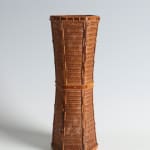Ishikawa Shōun
Hexagonal Ikebana Basket, 1950s
Bamboo and rattan
Size 16 x 6 x 5¼ in. (40.5 x 14.5 x 13.5 cm)
T-4933
Further images
-
(View a larger image of thumbnail 1
)

-
(View a larger image of thumbnail 2
)

-
(View a larger image of thumbnail 3
)

-
(View a larger image of thumbnail 4
)

-
(View a larger image of thumbnail 5
)

-
(View a larger image of thumbnail 6
)

-
(View a larger image of thumbnail 7
)

-
(View a larger image of thumbnail 8
)

-
(View a larger image of thumbnail 9
)

-
(View a larger image of thumbnail 10
)

Susudake (smoked bamboo), madake (standard bamboo), tō (rattan); asanoha hexagonal plaiting (base), ajiro-ami twill plaiting (sides), bending, wrapping, knotting Signed underneath with incised characters: Shōun saku Comes with a fitted...
Susudake (smoked bamboo), madake (standard bamboo), tō (rattan); asanoha hexagonal plaiting (base), ajiro-ami twill plaiting (sides), bending, wrapping, knotting
Signed underneath with incised characters: Shōun saku
Comes with a fitted wood tomobako storage box
Like many baskets woven in Japan’s Kanto region during the post-war years, this example makes effective use of contrasting materials and techniques. Structural components formed from susudake (bamboo that has darkened from many years of exposure to smoke from the kitchen hearth of a dismantled farm building) are combined with twill plaiting in standard madake bamboo, prepared using the masawari (radial splitting) technique, in contrast to the flat or tangential cutting customary elsewhere in Japan. Small, meticulous knots and extensive wrapping, both executed in tō (rattan, slender strands cut from a trailing imported Southeast Asian palm), secure the structural components to the plaited work. The waisted form, sometimes compared to that of a kinuta or traditional fulling block for textiles, contributes to the basket’s sculptural tension.
Born in Shimo-Nagano, Tochigi Prefecture (north of Tokyo), Ishikawa Shōun was the first apprentice of Iizuka Rōkansai (1890–1958) widely considered the greatest of all Japanese bamboo artists. He appears to have worked in Tokyo from about 1910, following the Iizuka’s family move there from Tochigi in search of broader commercial and artistic opportunities, and his work was selected—alongside that of Rōkansai and Rōkansai’s son Shōkansai (1919 – 2004)—for the special national exhibition held in 1940 to mark the 2,600th anniversary of the foundation of the Japanese Empire. During World War II Shōun evacuated back to Tochigi, but he returned to the capital after Japan’s defeat to resume his career. He produced baskets in a range of styles pioneered by his master and by Rōkansai’s elder brother Hōsai II (1872–1934), including both informal sculptural pieces made from broad strips of bamboo and tightly woven formal flower containers like this, using bamboo of different colors. Ishikawa Shōun’s baskets are in the Lloyd Cotsen Japanese Bamboo Basket Collection at the Asian Art Museum in San Francisco and the Naej Collection, among others.
For an example of this form by Nakata Kinseki (1902–1959), another member of the Iizuka lineage and participant in the 1940 exhibition, see A+C VWG, Baskets: Masterpieces of Japanese Bamboo Art, 1850-2015 [Catalogue of the Naej Collection]. n.p., 2017, cat. no. 203. For another basket by Shōun with strong similarities in construction to this example, see Erik Thomsen Gallery, Masterpieces of Japanese Bamboo Art, exhibition catalogue, New York, 2017, no. 14.
Signed underneath with incised characters: Shōun saku
Comes with a fitted wood tomobako storage box
Like many baskets woven in Japan’s Kanto region during the post-war years, this example makes effective use of contrasting materials and techniques. Structural components formed from susudake (bamboo that has darkened from many years of exposure to smoke from the kitchen hearth of a dismantled farm building) are combined with twill plaiting in standard madake bamboo, prepared using the masawari (radial splitting) technique, in contrast to the flat or tangential cutting customary elsewhere in Japan. Small, meticulous knots and extensive wrapping, both executed in tō (rattan, slender strands cut from a trailing imported Southeast Asian palm), secure the structural components to the plaited work. The waisted form, sometimes compared to that of a kinuta or traditional fulling block for textiles, contributes to the basket’s sculptural tension.
Born in Shimo-Nagano, Tochigi Prefecture (north of Tokyo), Ishikawa Shōun was the first apprentice of Iizuka Rōkansai (1890–1958) widely considered the greatest of all Japanese bamboo artists. He appears to have worked in Tokyo from about 1910, following the Iizuka’s family move there from Tochigi in search of broader commercial and artistic opportunities, and his work was selected—alongside that of Rōkansai and Rōkansai’s son Shōkansai (1919 – 2004)—for the special national exhibition held in 1940 to mark the 2,600th anniversary of the foundation of the Japanese Empire. During World War II Shōun evacuated back to Tochigi, but he returned to the capital after Japan’s defeat to resume his career. He produced baskets in a range of styles pioneered by his master and by Rōkansai’s elder brother Hōsai II (1872–1934), including both informal sculptural pieces made from broad strips of bamboo and tightly woven formal flower containers like this, using bamboo of different colors. Ishikawa Shōun’s baskets are in the Lloyd Cotsen Japanese Bamboo Basket Collection at the Asian Art Museum in San Francisco and the Naej Collection, among others.
For an example of this form by Nakata Kinseki (1902–1959), another member of the Iizuka lineage and participant in the 1940 exhibition, see A+C VWG, Baskets: Masterpieces of Japanese Bamboo Art, 1850-2015 [Catalogue of the Naej Collection]. n.p., 2017, cat. no. 203. For another basket by Shōun with strong similarities in construction to this example, see Erik Thomsen Gallery, Masterpieces of Japanese Bamboo Art, exhibition catalogue, New York, 2017, no. 14.









